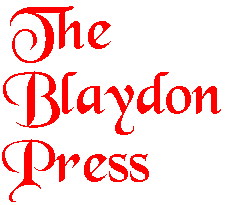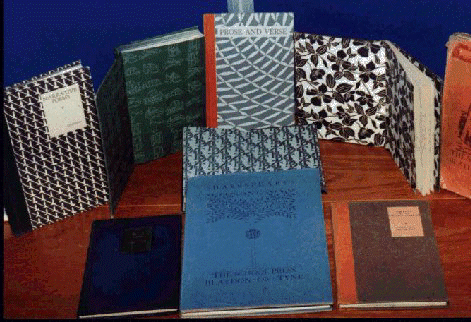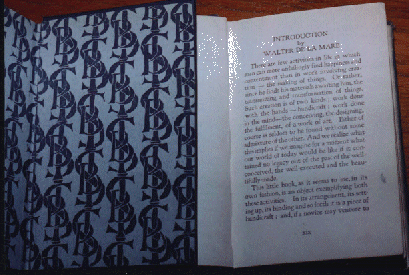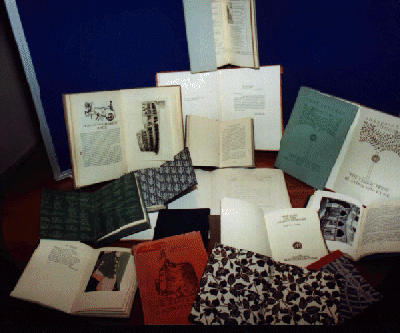| Back to the Inkpot Title Page |
 |
|
There was once a school in County Durham which printed and bound its own hardback books. Copies were exhibited at Oxford and were favourably compared with those of flourishing private presses such as the Nonesuch and the Gregynog. The poet Walter de la Mare wrote an introduction to one edition; Sir Charles Trevelyan wrote for another. The school was Blaydon Intermediate School, overlooking the Tyne at the junction of Shibdon Road and Shibdon Bank. A housing development now stands on the site, but copies of the books still exist as a memorial to a remarkable enterprise. It all began in 1933 when the English teacher, Mr V. H. Elliott, produced An Anthology of Verse for School Use. Having selected the verse, from Shakespeare to de la Mare, Mr Elliott supervised the typesetting on the school's Albion proofing press. Two pupils, Thomas Henry and Robert Hall, did the printing, and the finished book was given attractive endpapers and stapled into stiff board covers.
|
|
The first book was really only a pamphlet of 15 printed pages, but a spark had been fired and ambitions soared. Within two years Mr Elliott, joined now by the art teacher, Mr Boyce, had embarked on the production of a "real" book. Right: Some of the books produced by the Blaydon School Press |  |
|
Songs of Enchantment, 1935, is a 6 by 4 inch volume of 158 printed pages, bound in boards covered with navy blue buckram. The endpapers are a delight, printed over with a repeated pattern of the school initials. The triumph of the enterprise was the children's success in having Walter de la Mare write the introduction. Reluctant at first, de la Mare gladly consented once he realised that the children meant business.
|
|
In his introduction, de la Mare praises the teamwork involved in making the book, stressing that it was a labour of love. "And," he continues, "whatever benefits other incentives may bring, the best human work of any kind cannot but in large part be that." Right: Songs of Enchantment showing the endpaper and the introduction by de la Mare |  |
|
The project for 1936 was even more ambitious. Messrs Elliott and Boyce decided that not only should their pupils produce the books, they should also write the content. Progress was the result, an anthology of subjects in which the children themselves were interested. Part of the book consists of prophecies of life in the year 2000, some of which are uncannily close to truth. One boy, Edward Statters, wrote of robot production lines and ships of 100,000 tons. "There is not a home in the country," he wrote of the year 2000, "which has not a television set installed." Another contributor, Elsie Biggins, envisaged robot perambulators which took baby for an airing while mother watched progress on a television screen. The most accurate prediction was made by John James Haynes, who appears to have had a nightmare vision of the yuppie. "You will be able to carry a telephone apparatus in an attache case," he wrote, "and whenever you want to put a trunk call through or speak to your friend, you will just be able to unlock your case whenever you wish." Spurred by their success with Walter de la Mare, the children secured an introduction to the book from Sir Charles Trevelyan, Lord Lieutenant of Northumberland, who was genuinely impressed by their efforts. He invited them to Wallington Hall in the autumn of 1936. The visit formed the theme of the next publication, Wallington, bound in board with gold blocked title, sumptuous hand coloured drawings and black and white photographs. By then the teachers were confident enough to let a boy from Form III supervise the pupils of Form I in the printing. The trip to Wallington was a great success, not least because Sir Charles was not at all what the children expected. The head girl timidly rang the door bell, after which Sir Charles appeared in "his quaint country dress... Instead of the tall stately dignified gentleman ... as most of us expected him to be, he appeared to be a short, grey-headed figure in plus fours." Sir Charles showed the children over his house and grounds, posed for photographs, and presented the party with two books about Wallington. In a later broadcast he spoke fervently about the need for great houses to be taken up by the National Trust. With his permission, the editors included the text of the broadcast in Wallington. The outbreak of war posed problems concerning the supply of materials, but the Blaydon Press continued to flourish. Creativity in full flow resulted in Rhyme and Rhythm in 1941, superbly bound in morocco with gold blocked title and hand coloured etchings in the text. The content is entirely original, consisting of poems by the children. A typical example is this verse, Dreams, by Evelyn Curry:
|
|
When nights are long and weary And you've nothing nice to do, Just curl up in the old armchair And dream of things untrue. You'll dream of flying horses, Of talking blackbirds too; Perchance you'll see a snowdrop Of vivid royal blue. Right: "Rhyme and Rhythm" is in the bottom left hand corner of this picture |
 |
|
Further original work appeared in Make Believe, a record of the school Drama Weeks of the years up to 1943. The book includes original plays by the children: Bethlehem, George Stephenson and The Kilted Sprite. Other publications were Shakespeare's songs (the blue book in the foreground of the first picture near the top of this page), The Rime of the Ancient Mariner, and an anthology of narrative verse. The collection also includes bound copies of letters from and to Sir Charles Trevelyan, and the correspondence with Walter de la Mare. The overall achievement is probably unique. The de la Mare anthology was exhibited at Oxford in 1935. Contributors to the forewords - de la Mare and Trevelyan, together with local academics Dr. Ballard and Professor Stanley - were favourably impressed by what they found within the covers. Most impressive is the quiet modesty of the two teachers who undertook the work annually and who seem to have regarded their achievement as nothing more than what one should expect of an English secondary school.
|
Top of page
| Back to the Inkpot Title Page |
© Text: Paperless Writers 2000